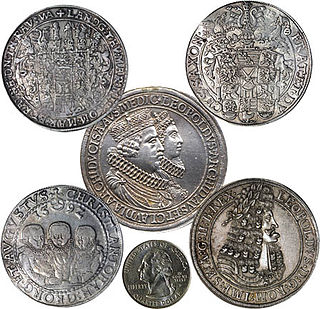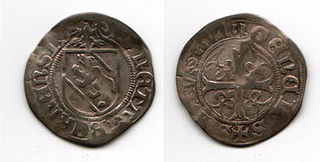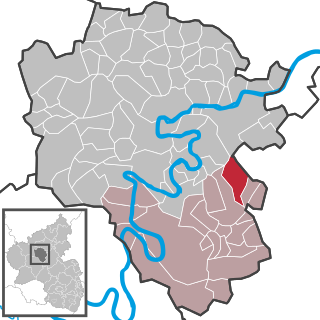Related Research Articles

A thaler or taler is one of the large silver coins minted in the states and territories of the Holy Roman Empire and the Habsburg monarchy during the Early Modern period. A thaler size silver coin has a diameter of about 40 mm and a weight of about 25 to 30 grams. The word is shortened from Joachimsthaler, the original thaler coin minted in Joachimstal, Bohemia, from 1520.
The 'pfennig' or penny is a former German coin or note, which was the official currency from the 9th century until the introduction of the euro in 2002. While a valuable coin during the Middle Ages, it lost its value through the years and was the minor coin of the Mark currencies in the German Reich, West Germany and East Germany, and the reunified Germany until the introduction of the euro. Pfennig was also the name of the subunit of the Danzig mark (1922–1923) and the Danzig gulden (1923–1939) in the Free City of Danzig.

The batzen is an historical Swiss, south German and Austrian coin. It was first produced in Berne, Switzerland, from 1492 and continued in use there until the mid-19th century.

Groschen is the name for various coins, especially a silver coin used in parts of Europe such as France, some of the Italian states, England, various states of the Holy Roman Empire, among others. The word is borrowed from the late Latin description of a tornose, a grossus denarius Turnosus, in English the "thick denarius of Tours". Groschen was frequently abbreviated in old documents to gl, whereby the second letter was not an l, but an abbreviation symbol; later it was written as Gr or g.

The German mark was the currency of the German Empire, which spanned from 1871 to 1918. The mark was paired with the minor unit of the pfennig (₰); 100 pfennigs were equivalent to 1 mark. The mark was on the gold standard from 1871–1914, but like most nations during World War I, the German Empire removed the gold backing in August 1914, and gold coins ceased to circulate.

The Kreuzer, in English usually kreutzer, was a coin and unit of currency in the southern German states prior to the introduction of the German gold mark in 1871/73, and in Austria and Switzerland. After 1760 it was made of copper. In south Germany the kreuzer was typically worth 4 pfennigs and there were 60 kreuzers to a gulden.

The Vereinsthaler was a standard silver coin used in most German states and the Austrian Empire in the years before German unification.

The Conventionstaler or Konventionstaler, was a standard silver coin in the Austrian Empire and the southern German states of the Holy Roman Empire from the mid-18th to early 19th-centuries. Its most famous example is the Maria Theresa thaler which is still minted today. The Conventionsgulden was equivalent to a 1⁄2Conventionsthaler.

The Reichsthaler, or more specifically the Reichsthaler specie, was a standard thaler silver coin introduced by the Holy Roman Empire in 1566 for use in all German states, minted in various versions for the next 300 years, and containing 25–26 grams fine silver.
The Prussian Thaler was the currency of Prussia until 1857. In 1750, Johann Philipp Graumann implemented the Graumannscher Fuß with 14 thalers issued to a Cologne Mark of fine silver, or 16.704 g per thaler.
The Vereinsthaler was the currency of the Kingdom of Hanover between 1857 and 1866. The Vereinsthaler replaced the prior Thaler at par. The Vereinsthaler was first subdivided into 24 Groschen, each of 12 Pfennig, thus 288 Pfennig = 1 Vereinsthaler. From 1858 on the subdivisions were more decimalised to 30 Groschen, each of 10 Pfennig, thus 300 Pfennig making up a Vereinsthaler.
The North German thaler was the currency of the Landgravate, then Electorate of Hesse-Kassel until 1858. Until 1807, the Thaler was subdivided into 32 Albus, each of 12 Heller. It was worth 3⁄4th a Conventionsthaler from 1754 to 1841.

Altstrimmig is an Ortsgemeinde – a municipality belonging to a Verbandsgemeinde, a kind of collective municipality – in the Cochem-Zell district in Rhineland-Palatinate, Germany. It belongs to the Verbandsgemeinde of Zell, whose seat is in the municipality of Zell an der Mosel.
The North German thaler was a currency used by several states of Northern Germany from 1690 to 1873, first under the Holy Roman Empire, then by the German Confederation. Originally equal to the Reichsthaler specie or silver coin from 1566 until the Kipper und Wipper crisis of 1618, a thaler currency unit worth less than the Reichsthaler specie was first defined in 1667 and became widely used after adoption of the Leipzig currency standard of 1690.

The history of Saxon coinage or Meissen-Saxon coinage comprises three major periods: the high medieval regional pfennig period, the late medieval pfennig period and the thaler period, which ended with the introduction of the mark in 1871/72. Rich silver deposits, which were discovered near Freiberg after the middle of the 12th century, helped Saxony to a leading position in German coinage.

The Roter Seufzer, also called the Seufzer and Leipziger Seufzer, was the popular name of the inferior six-pfennig coin minted in huge quantities in 1701 and 1702 by the Prince-Elector of Saxony and King of Poland, Augustus the Strong (1694–1733). The name of these coins was due to the loss that the population suffered as a result of the coins which had a high copper content.
A Münzfuß is an historical term, used especially in the Holy Roman Empire, for an official minting or coinage standard that determines how many coins of a given type were to be struck from a specified unit of weight of precious metal. The Münzfuß, or Fuß ("foot") for short in numismatics, determined a coin's fineness, i.e. how much of a precious metal it would contain. Mintmaster Julian Eberhard Volckmar Claus defined the standard in his 1753 work, Kurzgefaßte Anleitung zum Probieren und Münzen, as follows: "The appropriate proportion of metals and the weight of the coin, measured according to their internal and external worth, or determined according to their quality, additives and fineness, number and weight, is called the Münzfuß."

The schilling was the name of a coin in various historical European states and which gave its name to the English shilling. The schilling was a former currency in many of the German-speaking states of the Holy Roman Empire, including the Hanseatic city states of Hamburg and Lübeck, the March of Brandenburg, and the Duchies of Bavaria, Mecklenburg, and Württemberg. It was also used in Switzerland and in Austria, where silver schillings were introduced as recently as 1923.

On the founding of the German Empire in 1871, trade and transport was hampered by the existence of eight different currency systems across the various member states of the Empire. There were eight state currencies whose coins included the Thaler, Vereinsthaler, Konventionsthaler, Kreuzer, Heller, Groschen, Silbergroschen, Neugroschen, Gulden, Konventionsgulden, Schilling, Mark, Pfennig, Neu-Pfennig, Franc, Centime, Bremen Goldthaler, Groten, Schwaren, Prussian or Graumann Reichsthaler, Kurantthaler and Friedrich d'Or, which were all based on different gold and silver standards, making trade more difficult.

The Sechsling, also Sößling, Søsling (Dan./Norw.) or Sechser, was the name of a type of coin with a value of six Pfennigs, representing half a Groschen or half Schilling depending on the monetary system.
References
- ↑ Friedrich von Schrötter: Wörterbuch der Münzkunde. 2nd edn. 1970, p. 636.
